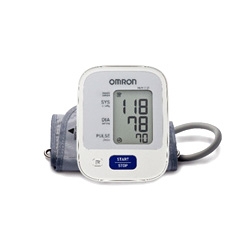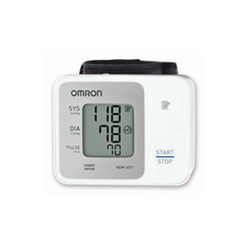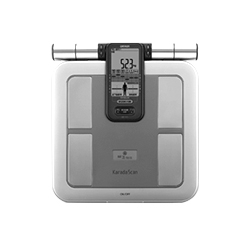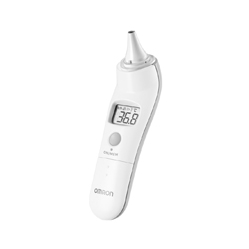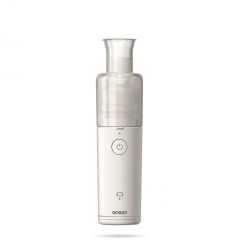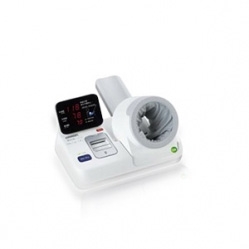Home>商品一覽表
POPULARIZATION OF HOME BLOOD PRESSURE MONITORING
Home blood pressure monitoring plays a very important role in a correct and careful blood pressure management to prevent cerebral stroke and myocardial infarction,and to detect morning hypertension today.The penetration of blood pressure monitor for home-use in Japan reached approx. 35 million units, and we can say that there is a unit in every home. However , when Omron started to develop the monitor in 1970s,there was no concept of measuring blood pressure at home among people and even in the medical world.Omron has been striving to popularize blood pressure measurement at home with the policy of " contributing to healthcare through the diagnosis technologies" since its beginning. Let us introduce how home blood pressure monitoring became popular.
 Omron launched its original manometer-typed manual blood pressure monitor (HEM-1) in 1973.
Omron launched its original manometer-typed manual blood pressure monitor (HEM-1) in 1973.
At that time, Japanese people were heated for the advocacy "Restructure of Japan", and also the oil crisis was triggered by the 4th Middle Eastern War. Although Japan was in the period of high economic growth, an initial salary for college graduate employee was about 57000 yen, and a blood pressure monitor was still expensive as 23800 yen.
Furthermore, there was no concept of blood pressure measurement at home in society, so the sales channel development needed to be elaborated so much.
We approached all different kinds of sales outlets such as stationary, tools and steel stores. Actually, a blood pressure monitor was displayed right next to a rice cooker or a calculator in stores at that time.
Health-consciousness grew more and more with the rich economic situation in the late 1970s. On the other hand, following the increased cerebral infarction caused by westernized eating habits, heart diseases such as myocardial infraction were increased in 1980s.
Many researches pointed out the biggest cause of cerebral infraction and myocardial infraction is hypertension by the time, and the Japanese Society of Hypertension was established in 1978 to promote hypertensive treatments and preventions.
 In the year, Omron launched its first "digital blood pressure monitor for home-use (HEM-77)", which is the first monitor that can display the readings with digital indication pursuing the usability.
In the year, Omron launched its first "digital blood pressure monitor for home-use (HEM-77)", which is the first monitor that can display the readings with digital indication pursuing the usability.
However, medical professionals defined that the blood pressure measurement should be conducted at a hospital, so the idea of home monitoring was not well received.
n those days, there was less understanding of conditions which are popular in recent years: readings raise only at a hospital and it is recognized as hypertension (white-coat hypertension) or readings become normal at a hospital but high outside (mask hypertension). Therefore, sometimes people misunderstood that the difference in readings at home and at a hospital is because of the inaccuracy of home-use monitor.
In spite of the situation, the hypertension studies continued to be progressed by foresighted medical researchers, and the importance of blood pressure at home is gradually understood.

 In addition to "accuracy" of blood pressure monitor, pursuing "usability" and "price friendliness" is also the important factor for the popularization of blood pressure measurement at home.
In addition to "accuracy" of blood pressure monitor, pursuing "usability" and "price friendliness" is also the important factor for the popularization of blood pressure measurement at home.
First "digital automatic blood pressure monitor (HEM-88)" launched in 1981 is the digital monitor with all automatic inflation, measurement, and deflation. "Blood pressure monitor with printer (HEM-50P)" launched in 1984 is one of the models that are easier to use and met the needs of the time.
Regarding price friendliness, we launched "digital manual blood pressure monitor (HEM-439)" with the price under 10000 yen for the first time in the market. As a starting salary for college graduates reached 140000 yen by then, we can say drastic price down was realized since our first monitor in 1973 which cost almost the half of the starting salary.
Actually, peoples' interests in home blood pressure measurement became progressively increased by the low-price monitor.
"Blood pressure monitor with Oscillometric method (HEM-400C, HEM-700C)" launched in 1986 had greater impact. Instead of the conventional Korotkoff method, the brand-new way is called oscillometric method; a measurement to detect the vibration of blood vessel wall.
The new method provides an excellent usability and highly improved reliability of readings, resulted to accelerate the spread of home-monitoring.

 In 1991, another significant model was launched. That is "fuzzy logic based automatic blood pressure monitor (HEM-706)" adapted the logic for the first time in the world. HEM-706 and the HEM-707 (blood pressure monitor with constant speed deflation control) launched in the following year realized the auto-set optimal inflation and deflation appropriate for each user. The solid technologies were established in the area of accuracy and usability to further support home-monitoring.
In 1991, another significant model was launched. That is "fuzzy logic based automatic blood pressure monitor (HEM-706)" adapted the logic for the first time in the world. HEM-706 and the HEM-707 (blood pressure monitor with constant speed deflation control) launched in the following year realized the auto-set optimal inflation and deflation appropriate for each user. The solid technologies were established in the area of accuracy and usability to further support home-monitoring.

 Omron continued to make an effort to popularize the blood pressure measurement at home through the development of monitors with higher usability and correct measurement such as "wrist blood pressure monitor with advanced positioning sensor (HEM-637IT)" in 2002 to guide the right wrist position, and our original "blood pressure monitor with full automatic cuff wrapping system (HEM-1000)", the mobile cuff automatically sets the correct position to measure launched in 2004. (See "Toward Accurate Blood Pressure Monitoring at Home" for the details of each model.)
Omron continued to make an effort to popularize the blood pressure measurement at home through the development of monitors with higher usability and correct measurement such as "wrist blood pressure monitor with advanced positioning sensor (HEM-637IT)" in 2002 to guide the right wrist position, and our original "blood pressure monitor with full automatic cuff wrapping system (HEM-1000)", the mobile cuff automatically sets the correct position to measure launched in 2004. (See "Toward Accurate Blood Pressure Monitoring at Home" for the details of each model.)
 Large-scale clinical researches regarding hypertension also influenced on the populization of blood pressure at home. One of the most important researches is Ohasama Study by Prof. Yutaka Imai from the Graduate School of Tohoku University and others started in 1986. Blood pressure monitors for home-use (HEM-401) were distributed to all residents (over 7 years old) in Ohasama-cho (Hanamaki-city in present) of Iwate prefecture. Residents measure the blood pressure in their daily lives, and researchers study the interaction between hypertension and diseases based on residents' data (on-going project.) This study is ground breaking as a long-term regional research using the home blood pressure as a health indicator. Through this research, it was scientifically validated that blood pressure monitoring at home is more effective than the measurement at a hospital to predict the events such as celebral stroke.
Large-scale clinical researches regarding hypertension also influenced on the populization of blood pressure at home. One of the most important researches is Ohasama Study by Prof. Yutaka Imai from the Graduate School of Tohoku University and others started in 1986. Blood pressure monitors for home-use (HEM-401) were distributed to all residents (over 7 years old) in Ohasama-cho (Hanamaki-city in present) of Iwate prefecture. Residents measure the blood pressure in their daily lives, and researchers study the interaction between hypertension and diseases based on residents' data (on-going project.) This study is ground breaking as a long-term regional research using the home blood pressure as a health indicator. Through this research, it was scientifically validated that blood pressure monitoring at home is more effective than the measurement at a hospital to predict the events such as celebral stroke.
The achievement of Ohasama Study was highly valued globally and later adapted to many guidelines of hypertension treatment. In addition to the "Guideline for Hypertension Treatment 2009" in Japan, the study become the standard of diagnostic criteria and the blood pressure goal also in western countries. (The study was adapted to Joint National Committee of U.S. in 1996, WHO in 1999, and European Society of Hypertension in 2007.)
Blood Pressure Management Research Group (representative: Shigeaki Hinohara, honorary director and chairperson of St Luke's International Hospital and the honorary president of St. Luke's College of Nursing) was also established in 1988. This group plays a significant role to share the research results and spread home blood pressure monitoring through the presentation of studies, lectures, and interacting information among researchers of hypertension category and physicians.
Hypertension became emphasized at the viewpoint of the prevention and treatment, and Ohasama study and the Blood Pressure Management Research Group were recognized more during 1990s and 2000s. Also, the researches on several conditions of hypertension were progressed in 2000s. Especially, the condition of morning hypertension, strong risk against celebral stroke or myocardial infarction, was pointed out by the research by Prof. Kazuomi Kario from Jichi Medical University. In other words, it was verified that the blood pressure monitoring at home is nessecary for the prevention and treatment of celebral stroke or myocardial infarction because morning hypertension may not be detected by blood pressure measurement at a hospital. (*1)
Omron has supported Ohasama study, Blood Pressure Management Research Group, the research on morning blood pressure by Prof. Kario and other projects for the advance of research and popularizaiton of blood pressure monitoring at home. (*2)
Those clinical investigatons and researches widely spreaded the importance of home blood pressure monitoring and led to build the trust in Omron's blood pressure monitor for home use in the medical world.
*1 Morning Hypertension: the blood pressure is usually low during the night and raise before awaking, which is called morning surge. However, there are some people whose morning blood pressure spikes extremely high or some whose blood pressure remains high because their blood pressure don't go down during the night and the morning spike added up the readings. Those type of hypertension is generally called morning hypertension. Morning hypertension is known as a risk of celebral stroke or myocardial infarction. The result of Ohasama Study shows about half of patients who are prescribed antihypertensive drugs have morning hypertensnion. It is essential to measure the blood pressure at home because morning hypertension may not be found by the blood pressure measurement at a hospital.
*2 In addition to Ohamasa Study, the activity of Blood Pressure Management Research Group, and the research on morning hypertension by Prof. Kario, Omron also supports "HOMED-BP Study (examine the goal for blood pressure at home)" which Tohoku University and many other medical institutes in Japan participated.
- Beginning of the Blood Pressure Monitor for Home-use
 Omron launched its original manometer-typed manual blood pressure monitor (HEM-1) in 1973.
Omron launched its original manometer-typed manual blood pressure monitor (HEM-1) in 1973.At that time, Japanese people were heated for the advocacy "Restructure of Japan", and also the oil crisis was triggered by the 4th Middle Eastern War. Although Japan was in the period of high economic growth, an initial salary for college graduate employee was about 57000 yen, and a blood pressure monitor was still expensive as 23800 yen.
Furthermore, there was no concept of blood pressure measurement at home in society, so the sales channel development needed to be elaborated so much.
We approached all different kinds of sales outlets such as stationary, tools and steel stores. Actually, a blood pressure monitor was displayed right next to a rice cooker or a calculator in stores at that time.
Health-consciousness grew more and more with the rich economic situation in the late 1970s. On the other hand, following the increased cerebral infarction caused by westernized eating habits, heart diseases such as myocardial infraction were increased in 1980s.
Many researches pointed out the biggest cause of cerebral infraction and myocardial infraction is hypertension by the time, and the Japanese Society of Hypertension was established in 1978 to promote hypertensive treatments and preventions.
 In the year, Omron launched its first "digital blood pressure monitor for home-use (HEM-77)", which is the first monitor that can display the readings with digital indication pursuing the usability.
In the year, Omron launched its first "digital blood pressure monitor for home-use (HEM-77)", which is the first monitor that can display the readings with digital indication pursuing the usability.However, medical professionals defined that the blood pressure measurement should be conducted at a hospital, so the idea of home monitoring was not well received.
n those days, there was less understanding of conditions which are popular in recent years: readings raise only at a hospital and it is recognized as hypertension (white-coat hypertension) or readings become normal at a hospital but high outside (mask hypertension). Therefore, sometimes people misunderstood that the difference in readings at home and at a hospital is because of the inaccuracy of home-use monitor.
In spite of the situation, the hypertension studies continued to be progressed by foresighted medical researchers, and the importance of blood pressure at home is gradually understood.
- Monitors that Contributed to the Popularization of Blood Pressure Measurement at Home

 In addition to "accuracy" of blood pressure monitor, pursuing "usability" and "price friendliness" is also the important factor for the popularization of blood pressure measurement at home.
In addition to "accuracy" of blood pressure monitor, pursuing "usability" and "price friendliness" is also the important factor for the popularization of blood pressure measurement at home.First "digital automatic blood pressure monitor (HEM-88)" launched in 1981 is the digital monitor with all automatic inflation, measurement, and deflation. "Blood pressure monitor with printer (HEM-50P)" launched in 1984 is one of the models that are easier to use and met the needs of the time.
Regarding price friendliness, we launched "digital manual blood pressure monitor (HEM-439)" with the price under 10000 yen for the first time in the market. As a starting salary for college graduates reached 140000 yen by then, we can say drastic price down was realized since our first monitor in 1973 which cost almost the half of the starting salary.
Actually, peoples' interests in home blood pressure measurement became progressively increased by the low-price monitor.
"Blood pressure monitor with Oscillometric method (HEM-400C, HEM-700C)" launched in 1986 had greater impact. Instead of the conventional Korotkoff method, the brand-new way is called oscillometric method; a measurement to detect the vibration of blood vessel wall.
The new method provides an excellent usability and highly improved reliability of readings, resulted to accelerate the spread of home-monitoring.

 In 1991, another significant model was launched. That is "fuzzy logic based automatic blood pressure monitor (HEM-706)" adapted the logic for the first time in the world. HEM-706 and the HEM-707 (blood pressure monitor with constant speed deflation control) launched in the following year realized the auto-set optimal inflation and deflation appropriate for each user. The solid technologies were established in the area of accuracy and usability to further support home-monitoring.
In 1991, another significant model was launched. That is "fuzzy logic based automatic blood pressure monitor (HEM-706)" adapted the logic for the first time in the world. HEM-706 and the HEM-707 (blood pressure monitor with constant speed deflation control) launched in the following year realized the auto-set optimal inflation and deflation appropriate for each user. The solid technologies were established in the area of accuracy and usability to further support home-monitoring.
 Omron continued to make an effort to popularize the blood pressure measurement at home through the development of monitors with higher usability and correct measurement such as "wrist blood pressure monitor with advanced positioning sensor (HEM-637IT)" in 2002 to guide the right wrist position, and our original "blood pressure monitor with full automatic cuff wrapping system (HEM-1000)", the mobile cuff automatically sets the correct position to measure launched in 2004. (See "Toward Accurate Blood Pressure Monitoring at Home" for the details of each model.)
Omron continued to make an effort to popularize the blood pressure measurement at home through the development of monitors with higher usability and correct measurement such as "wrist blood pressure monitor with advanced positioning sensor (HEM-637IT)" in 2002 to guide the right wrist position, and our original "blood pressure monitor with full automatic cuff wrapping system (HEM-1000)", the mobile cuff automatically sets the correct position to measure launched in 2004. (See "Toward Accurate Blood Pressure Monitoring at Home" for the details of each model.)- Importance of Clinical Research and Blood Pressure at Home
 Large-scale clinical researches regarding hypertension also influenced on the populization of blood pressure at home. One of the most important researches is Ohasama Study by Prof. Yutaka Imai from the Graduate School of Tohoku University and others started in 1986. Blood pressure monitors for home-use (HEM-401) were distributed to all residents (over 7 years old) in Ohasama-cho (Hanamaki-city in present) of Iwate prefecture. Residents measure the blood pressure in their daily lives, and researchers study the interaction between hypertension and diseases based on residents' data (on-going project.) This study is ground breaking as a long-term regional research using the home blood pressure as a health indicator. Through this research, it was scientifically validated that blood pressure monitoring at home is more effective than the measurement at a hospital to predict the events such as celebral stroke.
Large-scale clinical researches regarding hypertension also influenced on the populization of blood pressure at home. One of the most important researches is Ohasama Study by Prof. Yutaka Imai from the Graduate School of Tohoku University and others started in 1986. Blood pressure monitors for home-use (HEM-401) were distributed to all residents (over 7 years old) in Ohasama-cho (Hanamaki-city in present) of Iwate prefecture. Residents measure the blood pressure in their daily lives, and researchers study the interaction between hypertension and diseases based on residents' data (on-going project.) This study is ground breaking as a long-term regional research using the home blood pressure as a health indicator. Through this research, it was scientifically validated that blood pressure monitoring at home is more effective than the measurement at a hospital to predict the events such as celebral stroke.The achievement of Ohasama Study was highly valued globally and later adapted to many guidelines of hypertension treatment. In addition to the "Guideline for Hypertension Treatment 2009" in Japan, the study become the standard of diagnostic criteria and the blood pressure goal also in western countries. (The study was adapted to Joint National Committee of U.S. in 1996, WHO in 1999, and European Society of Hypertension in 2007.)
Blood Pressure Management Research Group (representative: Shigeaki Hinohara, honorary director and chairperson of St Luke's International Hospital and the honorary president of St. Luke's College of Nursing) was also established in 1988. This group plays a significant role to share the research results and spread home blood pressure monitoring through the presentation of studies, lectures, and interacting information among researchers of hypertension category and physicians.
Hypertension became emphasized at the viewpoint of the prevention and treatment, and Ohasama study and the Blood Pressure Management Research Group were recognized more during 1990s and 2000s. Also, the researches on several conditions of hypertension were progressed in 2000s. Especially, the condition of morning hypertension, strong risk against celebral stroke or myocardial infarction, was pointed out by the research by Prof. Kazuomi Kario from Jichi Medical University. In other words, it was verified that the blood pressure monitoring at home is nessecary for the prevention and treatment of celebral stroke or myocardial infarction because morning hypertension may not be detected by blood pressure measurement at a hospital. (*1)
Omron has supported Ohasama study, Blood Pressure Management Research Group, the research on morning blood pressure by Prof. Kario and other projects for the advance of research and popularizaiton of blood pressure monitoring at home. (*2)
Those clinical investigatons and researches widely spreaded the importance of home blood pressure monitoring and led to build the trust in Omron's blood pressure monitor for home use in the medical world.
*1 Morning Hypertension: the blood pressure is usually low during the night and raise before awaking, which is called morning surge. However, there are some people whose morning blood pressure spikes extremely high or some whose blood pressure remains high because their blood pressure don't go down during the night and the morning spike added up the readings. Those type of hypertension is generally called morning hypertension. Morning hypertension is known as a risk of celebral stroke or myocardial infarction. The result of Ohasama Study shows about half of patients who are prescribed antihypertensive drugs have morning hypertensnion. It is essential to measure the blood pressure at home because morning hypertension may not be found by the blood pressure measurement at a hospital.
*2 In addition to Ohamasa Study, the activity of Blood Pressure Management Research Group, and the research on morning hypertension by Prof. Kario, Omron also supports "HOMED-BP Study (examine the goal for blood pressure at home)" which Tohoku University and many other medical institutes in Japan participated.

